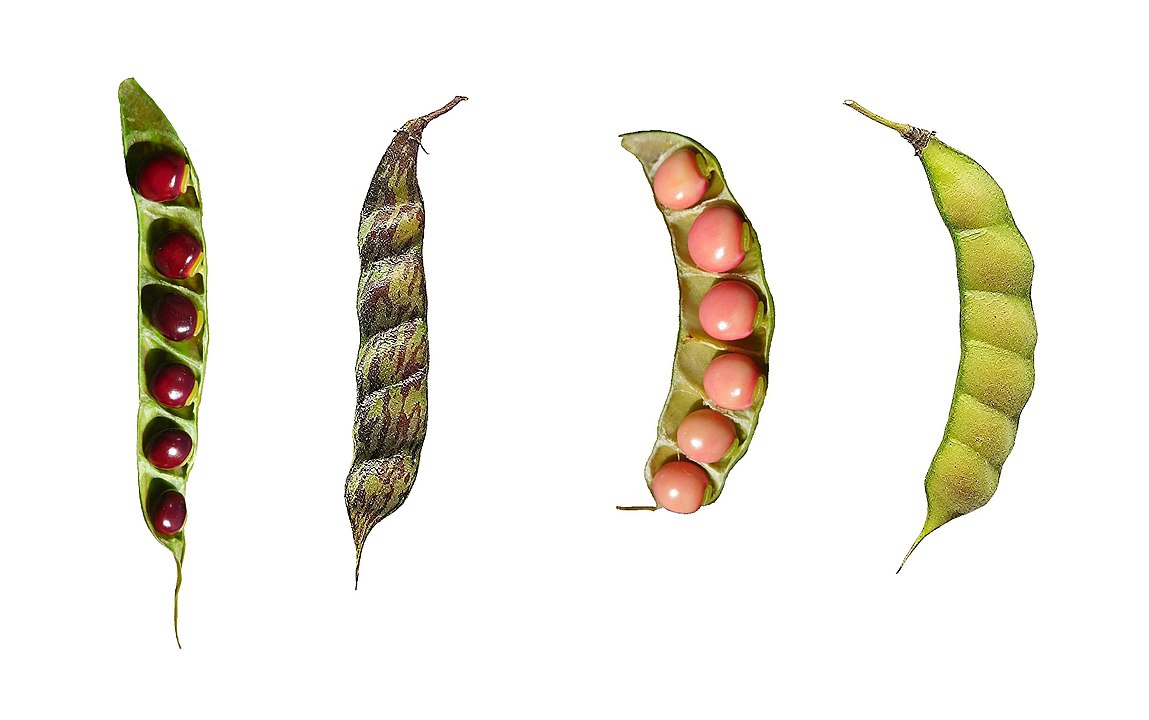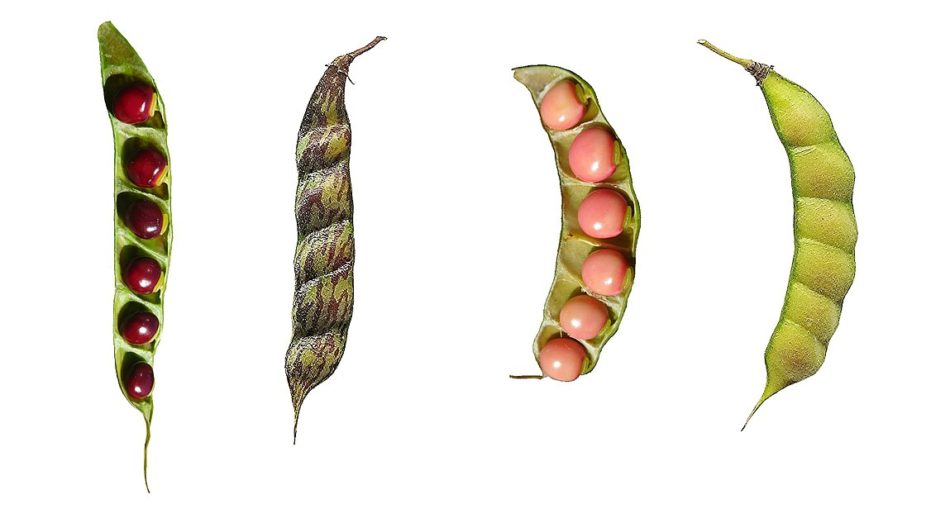Pigeon peas (Cajanus cajan) are tasty legumes from the family Fabaceae that are popular in Indian, African and Caribbean cooking, and make a healthy addition to any meal.
Origin Of Pigeon Peas
The cultivation of pigeon peas is dated back to at least 3,500 years. From India it traveled to East Africa and West Africa. There, it was first encountered by Europeans, so it obtained the name Congo Pea. By means of the slave trade, it came to the American continent, probably in the 17th century.

Pigeon Peas – Photo by: By Filo gèn’ – Own work, CC BY-SA 4.0, https://commons.wikimedia.org/w/index.php?curid=74839892
Description Of Pigeon Peas
Plant Pigeon peas usually lives around one to five years. It is grown annually, reaching a height of around 1-4 meters. Pigeon pea plants are woody near the base.
- Leaves – The leaves are comprised of three leaflets. They are pubescent and green on the upper side and silvery grayish-green having long hairs on the lower side. The leaflets can be either elliptic or lanceolate in shape. They are normally 2.5 cm to 10 cm long and almost 3.5 cm wide.
- Flower – The flower blossoms are yellow in color having red or reddish-brown lines. Sometimes the flowers may have a red lining on the outer edge. They are grown in terminal racemes. The flowers have a diameter ranging between 1.2 cm and 1.7 cm.
- Seeds – The seeds vary greatly in their color. They may be white, cream-yellow, brown or almost black. The seeds can be squarish, globose or ellipsoid.
- Roots – Pigeon pea has taproots which are tetrarch, thin and grows deep under the ground, reaching to a depth of six feet. The deep roots help in improving infiltration of water into the soil.
Varieties Of Pigeon Peas
There are various types of Pigeon pea plants
- Tree types
- Tall varieties
- Dwarf varieties
- Smaller bushes
Pigeon peas are a popular choice in many food preparations across the world. It has a high nutritional value and growing it is much easier compared to some other plants. It is drought-resistant and growing this plant is also beneficial for the surrounding area.
Nutritional Value Of Pigeon Peas
The serving size of one cup which measures 153 grams provides 43 mg of Vitamin C, 0.536 mg of Vitamin B1, 153 µg of Vitamin B9, 2.4 mg of iron, 0.69 mg of manganese, 181 mg of phosphorus, 29.82 gram of Carbohydrate, 3.294 mg of Vitamin B3 and others. The pigeon peas are rich in proteins, minerals, vitamins and lipids.
9 Healthy Benefits Of Pigeon Peas
- Maintains blood pressure – Potassium is the key mineral which is found in pigeon peas that acts as a vasodilator, reduces the blood constriction and also reduces blood pressure. Those who suffer from hypertension should add pigeon peas to the daily diet because they are highly prone to the cardiovascular disease.
- Assist in growth – Pigeon peas are also loaded with high protein content which is required for the growth and development. It is essential for the formation of cells, tissues, muscles and bones. It also assists in the healing process and cell regeneration in the body. One cup of cooked pigeon peas possesses 11 grams of protein.
- Prevent anemia – Folate is found in adequate amount in pigeon peas which helps to prevent anemia and neural tube defects in unborn which is caused due to the deficiency of folate. The intake of single cup of pigeon peas provides about 110% of the daily recommended vitamins.
- Anti-inflammatory properties – The seeds, leaves and peas of pigeon peas are used to treat inflammation due to the presence of organic compounds. The mashed pigeon peas paste is used as a treatment for piles which is known as hemorrhoids.
- Helps in losing weight – Pigeon peas possess low amount of calories, cholesterol and saturated fats which makes it healthy. The presence of dietary fiber keeps full for a long period of time, increase metabolism rate and reduces the possibilities of weight gain. The nutrients found in pigeon peas converts into the usable energy than to store as a fat.
- Boost energy – Vitamin B is also present in pigeon peas. Riboflavin and Niacin enhance the carbohydrate metabolism, prevent in fat storage and boost energy levels. It is suitable for the people living in arid climates, physical work that reduces the energy quickly.
- Aids immunity – To maintain the nutrients, raw is better because 25% of nutrients are lost when cooked. The uncooked peas help to enhance the immune system. Vitamin C promotes the white blood cells production and acts as an antioxidant that promotes in overall wellness as well as strong immunity.
- Healthy heart – Pigeon peas contain dietary fiber, potassium and low cholesterol which help to maintain the healthy heart. Potassium lowers the strain on heart by reducing the blood pressure. Dietary fiber maintains cholesterol balance and prevents atherosclerosis.
- Digestive health – Pigeon peas are rich in dietary fiber which is essential for maintaining the digestive health. Fiber adds bulk to the stool and enhances the bowel movements by reducing the strain as well as inflammation. It reduces the constipation, cramping, bloating and diarrhea. Fiber enhances the efficiency of nutrient absorption.
Traditional And Medicinal Uses Of Pigeon Peas Around The World
- It is also used as an astringent that is used to stop bleeding.
- It is also used to cure lungs and chest disease.
- It is used to eliminate the internal parasitic worms.
- In Panamanian folk medicine, it is used as a treatment for diabetes.
- It helps to cure jaundice, cough and bronchitis.
- In Malay traditional medicine, leaves decoction helps to treat coughs, abdominal troubles and diarrhea.
- The juice extracted from leaves is helpful for earache and sores.
- In Java, the pulped leaves are used as a treatment for herpes, sores and itches.
- In China, the roots are used as a sedative, expectorant, anthelmintic and vulnerary.
- The roots are used to treat throat inflammation, diarrhea and chlorosis.
- A poultice is used to lessen swellings.
- In Philippines, a decoction made from leaves is useful for diarrhea, cough and abdominal pains.
Culinary Uses Of Pigeon Peas
- In India, pigeon pea is used as dhal.
- In other parts of Asia, seeds are used to make tempeh or tofu.
- In Africa, dried seeds are used in sauces to accompany rice, cassava and yam.
- The immature seeds and pods are consumed fresh or added in soups as vegetables.
- In Central America, seeds of pigeon pea are canned and frozen.
- The seeds are used as flour dried peas and green vegetable peas.
- In India, the seeds are used as pulses whereas the young pods are used in sambhar.
- The fresh pods, young shoots and seeds are used as vegetables in sayor, spicy soups and other side-dishes in Southeast Asia and the Pacific.
- The young pods and leaves are added to various dishes in Indonesia and Ethiopia.
- The ripened seeds are consumed by roasting.
- The green pigeon pea with rice is considered as the main traditional food of Puerto Rican.
Here is how to make Pigeon Pea Soup with Broiled Plantains
Ingredients
- 2 cups shelled green pigeon peas
- ½ lb. chicken (cut)
- 1 onion cut)
- 6 cups water
- 2 stalk celery cut)
- salt
- 1 pepper
- 6 ozs sliced pumpkin
- 1 lb.eddo (cut)
- 2 small green plantains (cut)
- dumplings
- Oil
- 1 large carrot
Method
- Heat oil and saute pepper, onion, celery and pumpkin.
- Add chicken and fry until light brown.
- Then add peas and some water.
- Next, add eddo, carrot, plantains and cover with water.
- Stir and add salt and dumplings.
- Add enough water to cover everything in pot and allow to boil.
- Serve warm.
About Pigeon Peas
They are tasty legumes from the family Fabaceae. Its origin is from Indian and can be found worldwide. In Guyana, pigeon peas are added to cook up rice and soups. They are 4 varieties of pigeon peas. Some of its health benefits include: boosts energy, healthy heart and digestive health, just to name a few. It also have many traditional and medicinal uses.
Article References:
- https://www.onlyfoods.net/pigeon-peas.html
- https://nuts.com/cookingbaking/beans/pigeon-peas.html
- https://en.wikipedia.org/wiki/Pigeon_pea
- https://www.healthbenefitstimes.com/pigeon-pea/
- http://www.caribbeanchoice.com/recipes/recipe.asp?recipe=92
Last Updated: 2020-07-01







